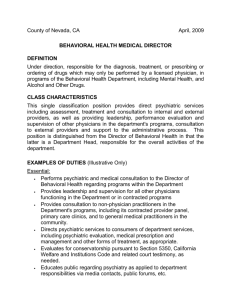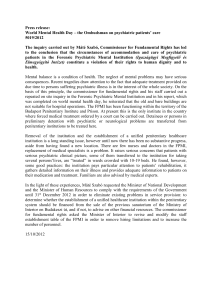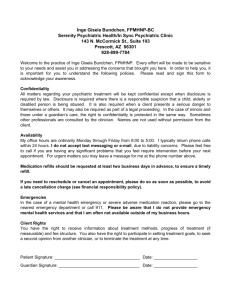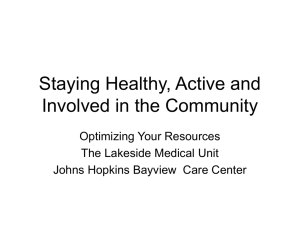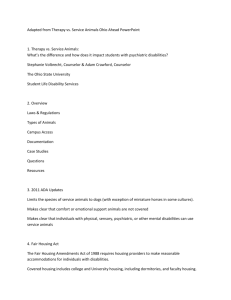www.chrusp.org March 20, 2013 Submission to the Committee on
advertisement
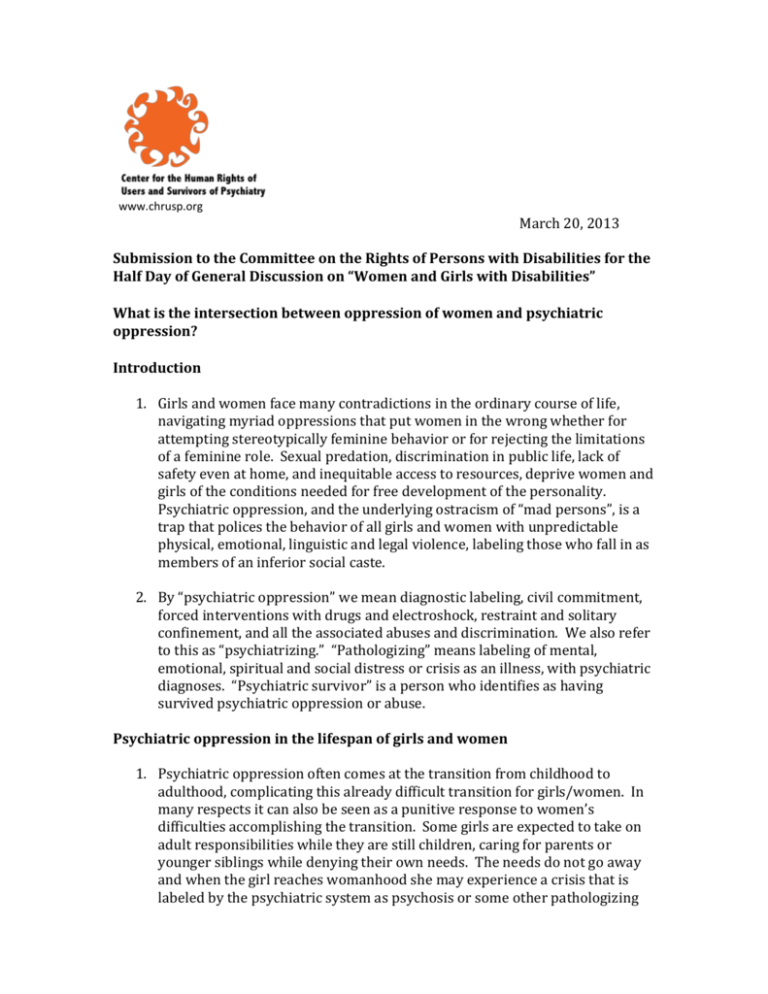
www.chrusp.org March 20, 2013 Submission to the Committee on the Rights of Persons with Disabilities for the Half Day of General Discussion on “Women and Girls with Disabilities” What is the intersection between oppression of women and psychiatric oppression? Introduction 1. Girls and women face many contradictions in the ordinary course of life, navigating myriad oppressions that put women in the wrong whether for attempting stereotypically feminine behavior or for rejecting the limitations of a feminine role. Sexual predation, discrimination in public life, lack of safety even at home, and inequitable access to resources, deprive women and girls of the conditions needed for free development of the personality. Psychiatric oppression, and the underlying ostracism of “mad persons”, is a trap that polices the behavior of all girls and women with unpredictable physical, emotional, linguistic and legal violence, labeling those who fall in as members of an inferior social caste. 2. By “psychiatric oppression” we mean diagnostic labeling, civil commitment, forced interventions with drugs and electroshock, restraint and solitary confinement, and all the associated abuses and discrimination. We also refer to this as “psychiatrizing.” “Pathologizing” means labeling of mental, emotional, spiritual and social distress or crisis as an illness, with psychiatric diagnoses. “Psychiatric survivor” is a person who identifies as having survived psychiatric oppression or abuse. Psychiatric oppression in the lifespan of girls and women 1. Psychiatric oppression often comes at the transition from childhood to adulthood, complicating this already difficult transition for girls/women. In many respects it can also be seen as a punitive response to women’s difficulties accomplishing the transition. Some girls are expected to take on adult responsibilities while they are still children, caring for parents or younger siblings while denying their own needs. The needs do not go away and when the girl reaches womanhood she may experience a crisis that is labeled by the psychiatric system as psychosis or some other pathologizing diagnosis. Some girls are pathologized and put into the psychiatric system as children, and are deprived of ordinary life and development, including education, for many years, which can hinder them in adult life. In many cases, girls and women are psychiatrized for reacting to rape or other sexual violence, or as part of a pattern of domestic violence. I was originally taken for electroshock at age 17 because I slept too much to suit my parents, and because I argued with my father who was drunk every night on 4 or more martinis. I had mononucleosis and was tired and sleepy, but even though everyone knew that I had mono, no one made the connection between my need for sleep and having mono. (This connection was known even in 1965.) My parents did not want me to participate in any talk therapy and did not want anyone to know about their drinking or about their marital problems (they were on the verge of divorce). The next year, I was abducted at the airport (by my parents) and put in a mental hospital because my mother had been drinking and did not remember that she had told me over the phone to come home from college. She thought I had just decided to come home out of the blue. No one believed me when I told them I had cleared my return with my parents before I flew home. In the records from the hospital repeatedly it is stated that I kept saying I had cleared my return with my parents, but because my parents did not remember the phone call, no one believed me, and I was thought to be making it up. This led to three more years of outpatient maintenance electroshock and major tranquilizers. Yes, families can scapegoat people and can use the mental health system to do so. I begged my parents to get a second opinion, and begged them to let me talk to a psychologist or counselor, but my mother's defensive response was "The insurance pays 80% for the psychiatrist and only 50% for a psychologist, and besides, psychologists always say it's all the mother's fault." - Anonymous (U.S.) 2. In addition, the adult roles open to women have been in transition themselves for the last half-century or so, and adulthood for women is not as clear a status distinguished from childhood, as it is for men. Women did not have equal legal capacity as men until comparatively recently, and do not enjoy full equality under the law in many countries including the United States. Derogatory expressions towards women, particularly those who assert leadership or boldly pursue personal ambitions (whether for personal satisfaction or social justice or both), still hinder women’s full self-expression and contributions to humanity. Women are still at times referred to as “girls” past the age of maturity, while boys on the contrary can be referred to as “men” before they become adults. Asserting personal authority or social authority demands of women a skill and sensitivity that can be challenging, and this can lead to psychiatric labeling when the woman experiences personal crisis as a result or when she comes into conflict with others who both enact gender politics and deny the relevance of gender in the situation. Women who react to years of domestic violence by killing the abuser can be imprisoned for life in the psychiatric system following a verdict of “not guilty by reason of insanity.” As women age, there are additional challenges of reduced social respect, impoverishment and vulnerability to economic exploitation and deprivation of legal capacity. Psychiatric oppression and the feminist account of women’s lives 3. Feminists have criticized the pathologizing of women’s resistance to oppression, yet by and large have failed to appreciate the depth to which this is present in all psychiatric labeling, thus perpetuating a distinction between “mad” and “sane” women and perpetuating the power of psychiatry to make this distinction. It is not only when a woman is actively rebelling against patriarchal gender roles requiring her to be meek and submissive to men, that psychiatric labeling is inappropriate. When a woman is trying to conform to gender role expectations she may be equally likely to be pathologized as “too” passive. Self-expression that not only violates social norms but also confronts others with a depth of pain and contradiction that is uncomfortable to face, like self-injury (cutting), or retreating into silence, or taking one’s clothes off in public, does not need to be fully understandable as an expression of gender politics, to matter as a reflection of women’s and girls’ experience that has meaning. This is true also of the self-expression of boys and men. 4. Psychiatric oppression removes women from many of the opportunities to struggle with gender politics and actively contribute to the social transition towards gender equality and equity. It is not so much that there is an intersection of oppressions based on different facets of personal identity, but that psychiatric oppression places a person into a social caste with inferior legal rights and inferior access to resources and to the means to defend oneself against violations. In that sense psychiatric oppression is related to other intersecting oppressions like poverty, or women who are sex workers or who live in the streets. There is a qualitative difference in experience to that of other women who have never been segregated in that way, and it creates a gulf between women and an omission of aspects of women’s experience from much of the feminist account of women’s lives. 5. Psychiatric oppression is more than the fact of madness or alleged madness, and more than being institutionalized and forcibly drugged or electroshocked. It means that a woman might lose her home and job, and have difficulty getting work because of gaps in work history that cannot be explained without divulging information that can be used against the person for discriminatory reasons. It means that a woman might be living in congregate mental health housing, which can impose demeaning requirements such as taking unwanted psychiatric drugs and allowing staff to enter at any time, because she cannot afford her own apartment on a disability pension and there are no friends or family with whom she can share living space. It means that a woman might be living in the community under an outpatient commitment order, required to take drugs and attend psychiatric programs, even if she has her own apartment and would prefer to get a job or go to school. It means that a woman might be less self-confident, less assured of a welcome for the whole of who she is, having the memory of being treated as if she were nothing as a “mental patient” in an institution, which the society around her does not condemn but actually endorses as public policy. It means that she might be a “childless mother” whose children were taken away due to prejudice and fear after she was institutionalized. She might experience cognitive disabilities resulting from electroshock or tardive dyskinesia and other health problems from psychiatric drugs. Women in the psychiatric survivor movement 6. In the psychiatric survivor movement, women often take leadership roles, but it is difficult to address gender politics aside from issues of rape (trauma particularly from childhood rape as a cause of distress and crisis that gets responded to by psychiatrizing, and also rape in institutions), and discrimination in child custody. The politics of women’s liberation is not universally accepted in the psychiatric survivor movement, particularly reproductive freedoms and the choice to terminate a pregnancy, women’s right to function as assertive leaders and to not present themselves as maternal, and rejection of sexist cultural materials. The contents of men’s subjective experiences of trauma and injustice, as well as their religious and spiritual beliefs, often include sexist material, which can be difficult for women to confront when it arises in peer support. (The same is true for people of color dealing with white people’s subjective experience and beliefs that include racist material.) Women may face judgment in peer support settings regarding expression of anger (still reacted to as a male prerogative) and articulation of a politics of women’s liberation, and may not be able to trust the group with their most meaningful experiences or beliefs. Lesbian experience beyond the mere fact of orientation towards same-sex partners is invisible in the psychiatric survivor movement, in particular the richness of lesbian-feminist culture and spirituality. Intersecting oppression 7. Thus in many ways the intersection of psychiatric oppression and women’s oppression resembles a gap rather a fertile space. A female survivor of psychiatry, particularly if she is a lesbian (and/or a woman of color/cultural minority woman), and if her experience of women’s oppression is not centered on sexuality and reproduction, may find no “home” in any social justice movement or in mainstream society, while at the same time she may well make significant contributions to the feminist movement, the user/survivor movement, the disability movement and society as a whole. Since the user/survivor movement is both politically small and a matter of urgency for those of us whose priority is resisting psychiatric oppression, there has been little opportunity to develop a substantial political space of female users and survivors of psychiatry. In the CRPD drafting and negotiations, we participated actively in work on Article 6 and gender issues, particularly at the beginning of those discussions, but when the women’s caucus was holding all-day meetings near the end of the process, we fell away because our priority had to be the articles on legal capacity, liberty and integrity/free and informed consent that would secure our legal equality and freedom. Our contributions are seen in some of the earlier International Disability Caucus proposals for Article 6, which included references to women’s autonomy. Recommendations 8. State obligations towards female users and survivors of psychiatry under the CRPD remain centered on the articles that secure our legal equality and freedom. It is essential to do away with substituted decision-making and disability-based defenses that preclude criminal responsibility,1 and to abolish civil commitment and forced or coerced psychiatric interventions, which have been recognized as acts of torture and ill-treatment2 and as acts of violence against women.3 In implementing Article 6 and other genderrelated provisions of the CRPD, it will be necessary for states to address these legal and practical obstacles to the advancement, empowerment and equality of women with psychosocial disabilities, otherwise measures for the advancement of women will fail to achieve these aims for women with psychosocial disabilities, leaving us further behind. 9. Furthermore states should take account of the ways in which social and legal oppression of women, and violence against women, contribute to the kinds of personal or social crisis for which women may seek mental health services, or during which they come to be incarcerated in the psychiatric system. These gender-based injustices need to be addressed at the root, rather than targeting women for mental health screening that perpetuates a pathologizing approach to women’s lives and needs. States should recognize the ways in which psychiatric violence functions as an extension of domestic violence, and should support social transformations that promote women’s equality with men as well as the elimination of medical/legal authority over women’s and girls’ lives, including women and girls whose reactions to trauma take the form of serious crisis and distress. Furthermore, in implementing a shift from medical model to alternative services and supports, states need to ensure that such services and supports are able to identify with female-centered life perspectives. Office of the High Commissioner for Human Rights, A/HRC/10/48, paragraph 47. Special Rapporteur on Torture, E/CN.4/1986/15, paras 118-119; A/63/175 (2008) paras 38, 40, 41, 44, 47, 61-65; A/HRC/22/53 (2013) especially paras 85(e) and 89 (and see clarifications made in Mr Mendez’s statement to the Human Rights Council on 4 March 2013, that deprivation of liberty on mental health grounds is not justified by a motivation to protect the person or others). 3 See Statement by Rashida Manjoo, Special Rapporteur on Violence against Women, at side event on violence against women and girls with disabilities, 12 October 2012 (New York). 1 2 10. In keeping with other treaty bodies that have invoked a right to remedy and reparations for violations following the issuance of UN Guidelines on the subject, the CRPD Committee should call for immediate action to cease violations against the autonomy and integrity of women with disabilities and of all persons with disabilities, and to institute measures of remedy and reparation for victims. Articles 4 and 16 support such actions, and in the interpretation of Article 16 the Committee must include all forms of violence including forced psychiatric interventions. Remedy and reparations need to be undertaken in a spirit of holistic and comprehensive commitment to reversing the measures that violate human rights and involving victims of violations as full partners in every step of the process, particularly in telling their individual stories and having opportunities to collectively develop a framework and particular suggestions for reparation measures. As part of these measures, a holistic open political space needs to be created for female users and survivors of psychiatry to consider in full the varied dimensions of their experiences. References Bonnie Burstow, ECT as Violence Against Women, 12 Violence Against Women 372 (Apr 2006). Tina Minkowitz, Psychiatric Assault as Violence Against Women, Center for the Human Rights of Users and Survivors of Psychiatry (CHRUSP), available at www.chrusp.org/home/resources. First Person Stories on Forced Interventions and Being Deprived of Legal Capacity, WNUSP and Bapu Trust 2006, available at: http://www.scribd.com/doc/55987517/First-Person-Stories-on-ForcedInterventions-and-Being-Deprived-of-Legal-Capacity. International Network of Women with Disabilities (INWWD), Barbara Faye Waxman Fiduccia Paper on Violence Against Women with Disabilities , published by the Center for Women Policy Studies (March 2011), http://www.centerwomenpolicy.org/programs/waxmanfiduccia/2011OnlineSeries BarbaraWaxmanFiduccia.asp. Myra Kovary, Interdependence: Including Women with Disabilities in the Agenda of the Women’s Movement – Our Fears, Realities, Hopes, and Dreams, presentation at CRPD Conference of States Parties (2012). A Robb, A Sentience Explored: A journey into the experiential meanings of middleclass South African women diagnosed with Bipolar Disorder, unpublished thesis, University of Western Cape, Cape Town (2010). World Network of Users and Survivors of Psychiatry (WNUSP), Submission for Joint CEDAW-CRC General Recommendation/ General Comment on Harmful Practices: Recognizing Forced and Coerced Psychiatric Interventions Against Women, Men and Children as a Harmful Cultural Practice (2011). The Center for the Human Rights of Users and Survivors of Psychiatry (CHRUSP) provides strategic leadership in human rights advocacy, implementation and monitoring relevant to people experiencing madness, mental health problems or trauma. In particular, CHRUSP works for full legal capacity for all, an end to forced drugging, forced electroshock and psychiatric incarceration, and for support that respects individual integrity and free will. Tina Minkowitz, Esq. tminkowitz@earthlink.net www.chrusp.org
